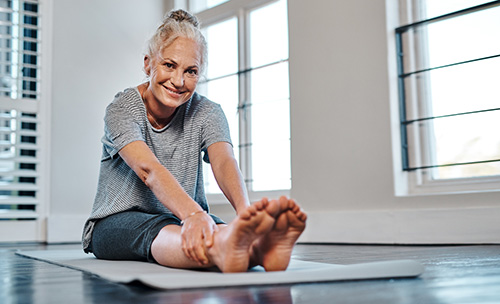If you’ve already been diagnosed with endometriosis, you probably know all too well the pain and frustration that can come with it. Many other women who suffer from endometriosis don’t even know they have it. This is because a definitive diagnosis is not all that easy to make.

What’s more, many women with endometriosis don’t realize that there are a range of therapies available, many of which are non-invasive. These may offer sufficient relief and allow at least some women to avoid more invasive solutions, such as surgery and drugs.
Starting with a more natural approach can also help address some of the underlying factors that caused or may worsen the symptoms of endometriosis. While the origins of endometriosis are unknown, the natural approach to managing the condition is based on the concept that a woman’s hormonal imbalance contributes to the type and severity of the symptoms.
What is endometriosis?
Endometriosis is a disorder in which the tissue that lines the inside the uterus — the endometrium — is also present in other parts of the body, such as the fallopian tubes, ovaries, intestines and bladder. In some women, even the lungs can be affected. Genetic predisposition appears to be the biggest risk factor.
Different theories have been proposed about how that tissue gets to these locations. What’s most significant is the fact that this endometrial tissue — no matter where in the body it is — responds to the same hormonal signals that regulate your menstrual cycle, engorging itself during the first half of the cycle, and then sloughing off (bleeding) with the onset of your period in the second half. When this occurs in tissues outside of the uterus, irritation, pain, and/or scarring can result. It is thought that that this scarring on reproductive organs can cause infertility in some women with endometriosis.
Symptoms of endometriosis
- Chronic pelvic pain
- Severe menstrual cramps
- Painful intercourse
- Heavy or irregular periods
- Low back pain
- Painful bowel movements or urination
- Gastrointestinal symptoms such as bloating, constipation, diarrhea, nausea or vomiting
A definitive diagnosis of endometriosis depends on direct visualization of this abnormal tissue — usually via a laparoscopic exam and possible biopsy. Symptoms vary depending on where the endometriosis is situated, with the most common symptom being chronic pelvic pain. Other major symptoms include severe menstrual cramps, painful intercourse, and heavy or irregular periods. These symptoms can heighten suspicion, but they still aren’t conclusive for endometriosis. Notably, about one-third of women with endometriosis have no symptoms at all, whereas other women may have some of these symptoms but not endometriosis. An experienced practitioner can get some hints from a pelvic exam, but again, the only definitive diagnosis is surgical. We recommend a natural approach as a first step to see if it provides symptom relief.
The exact cause of endometriosis is not known, and the many plausible theories suggest there are probably multiple pathways to developing the condition. One very clear factor, however, is the powerful role that estrogen plays in the disease.
Our estrogenic environment
Estrogen naturally stimulates cell growth in tissues containing estrogen receptors. But excess estrogen in turn causes excessive growth of this tissue, which can promote increased bleeding and irritation of tissue, especially when the endometriosis is located in an area that’s very exposed to circulating estrogen. To make matters worse, endometriotic tissue contains an enzyme (aromatase) that converts testosterone to estrogen. As a result, it’s able to make its own estrogen, which then stimulates that tissue even more. Fat tissue contains this same enzyme, which is why slimming down for a woman who’s overweight can be a powerful way to reduce estrogen levels.

It appears that our external estrogenic environment may also contribute to the development of endometriosis and to the severity of its symptoms. Some of the chemicals in our environment, especially pesticides, have molecular structures that resemble our own estrogen. As a result, these compounds — also called xenoestrogens — can exert estrogen-like actions on the body, even though they don’t raise the actual blood levels of estrogen. Two organochloride pesticides, dioxins and PCBs, have been linked specifically to endometriosis.
A 2010 study also showed that women with the highest blood levels of aromatic fungicides (sprayed on fruit and other crops) were five times more likely to have endometriosis compared to women with the lowest levels. These “endocrine disruptors” are particularly worrisome in that they’re able to persist for a very long time in the environment (and the body). Not surprisingly, xenoestrogens are pervasive. Non-organic foods and food packaging materials, such as plastics, are the most common sources of exposure. (See our article on endocrine disruptors for additional information on sources of xenoestrogens and ways to avoid them.)
The role of inflammation
Research also suggests that the immune system behaves abnormally in tissues affected by endometriosis. While some important functions of the immune system are suppressed, other parts appear to be overactive, including the production of antibodies against our own ovarian and uterine cells. Specific white blood cells and inflammatory compounds (e.g., cytokines, prostaglandins) are concentrated in endometriosis lesions, triggering inflammation in these tissues. The greater the inflammation, the worse the pain and other symptoms are. Fortunately, there are many ways to reduce inflammation naturally.
Natural treatment of endometriosis
Endometriosis appears to resolve by itself in one-third of women who don’t receive treatment. Unfortunately, in other women, it tends to progress, and unpredictably. Many women achieve success with a combination of dietary changes, nutrient support, alternative therapies such as acupuncture and phytotherapy, and emotional healing, all of which are factors in healthy hormonal balance. The basic strategy is to eliminate the underlying contributors to endometriosis and support your body’s healthy metabolic and endocrine function. These steps can help relieve the symptoms of endometriosis, but are also important preventive measures for overall health. We recommend that all women follow these natural steps, whether or not they suspect endometriosis.
-
- Eat a diet that counteracts endometriosis.
- Change your diet to minimize xenoestrogen exposure. As much as you can, eliminate non-organic sources of dairy products, beef and chicken.
- Reduce your intake of sugar and simple carbohydrates. In one study, this step significantly reduced symptoms in women with endometriosis.
- Increase nutrient-rich foods, especially cruciferous vegetables, non-GMO soy, cold-water fish and fiber, all of which support hormonal balance and help clear excess estrogen.
- Follow a whole-foods diet, being mindful of carbohydrates, to support healthy insulin metabolism and overall hormonal balance. This includes limiting alcohol intake, which has estrogen-enhancing effects on the body.
- Include high-fiber foods in your diet, which can help lower estrogen levels by modifying the balance of bacteria in your intestine.
- Maintain healthy levels of body fat to limit estrogen production. Body fat is also a storage site for xenoestrogens that may exacerbate endometriosis.
- Supplement with vitamins and minerals to make up for what your daily diet lacks, including calcium and magnesium, as well as B vitamins, which help detoxify estrogen.
- Supplement with phytotherapy (medicinal herbs) to gently normalize hormone activity. Examples are chaste tree berry (which supports progesterone production) and anti-inflammatory herbs like curcumin, from turmeric. Using bioidentical progesterone during the second half of the menstrual cycle can help relieve pain, and increase fertility, if desired.
- Avoid trans fats in your diet, and supplement with omega–3 fatty acids as a natural anti-inflammatory. A large study showed that women with the highest intake of trans fats were almost 50% more likely to develop endometriosis than women with the lowest intake, whereas women with the highest intake of omega-3 fats were the most protected.
- Minimize exposure to xenoestrogens in your environment. Be careful to not microwave food in plastic wrap or containers, and avoid the use of plastic wrap for food storage. Use glass instead.
- If you have endometriosis, consider adding acupuncture or physical therapy with pelvic massage to the above action steps. Castor oil packs will help reduce pain and inflammation.

Emotional factors
Today there is much greater recognition of the impact that emotional experience has on our health. There is a conclusive body of clinical evidence showing that stress increases the risk of many types of disease. A large-scale California study co-sponsored by the Center for Disease Control showed that emotional trauma in childhood almost predetermined having health problems in adulthood. Dozens of such studies are now published every year.
Endometriosis, especially the pain associated with it, may be made more severe by unresolved emotional issues, especially within your family of origin. Dealing with those issues now, especially when you can add in dietary and other support efforts outlined above, can be a decisive component of self-care. There are many alternative methods for help with emotional issues, as well as conventional counseling. Check around and go with what feels like the best fit for you.
Conventional medical treatment
The natural methods described above provide the support the body needs for hormonal balance and are all that many women need to get relief from their endometriosis symptoms. However, there are also many effective conventional remedies that are non-surgical. We suggest you start with a natural approach, if possible, and stick with it, but if you need more aggressive support, consider some of the following treatments:
-
- Ibuprofen, naproxen, or other non-steroidal anti-inflammatories (NSAIDs) that are available over-the-counter or by prescription, may decrease pain and inflammation when needed. (Studies have not clearly proven that NSAIDs are effective in endometriosis, and, of course, they often come with side effects, so be careful with long-term usage.)
- Medical/hormonal management with contraceptive methods such as birth control pills, patch or ring, or Depo-Provera injections, which contain synthetic progestins, helps block the stimulation of the endometriosis lesions. Hormonal treatments such as Lupron or danazol temporarily stop menstruation, block estrogen, and shrink the lesions.
- In extreme cases, where less-invasive approaches have failed to provide relief, surgical treatment may be your best option:
- Surgical removal or lasering of the tissue implants, usually following a course of Lupron.
- Endometrial ablation.
- Total or partial hysterectomy if the endometriosis is diffuse in the pelvic area.
How natural support can help no matter which road you choose
Talk with your doctor about all your options and the benefits of each. Whether you start with a natural approach or use it in addition to more conventional medical therapy, our Hormonal Health Program can help your body return to a state of natural hormonal balance:
1. Our Herbal Equilibrium contains a spectrum of botanical extracts that can help balance all three of the hormones most prone to flux: estrogen, progesterone, and testosterone.
2. Targeted and general nutrition are absolutely crucial in order to restore hormonal balance. A few shifts in your diet and supplementation with a good multivitamin formulated just for women can provide your body with the raw materials necessary for balance and healthy hormone production.
3. Add in a few lifestyle modifications to ensure that you get more sleep and relaxation. Finding the right kind of exercise for you is important both for hormonal and overall health.
This approach has helped tens of thousands of women regain hormonal balance and make changes that have transformed their lives. We believe you can find your own path back to balance, starting today.
Further reading
Women’s Bodies, Women’s Wisdom
by Christiane Northrup
Endometriosis: Healing Through Nutrition
by Dian Shepperson Mills, Michael Vernon
Explaining Endometriosis
by Lorraine Henderson, Ros Wood
Natural Treatment of Fibroid Tumors and Endometriosis
by Susan Lark
References
Hudson T. Endometriosis. In: Pizzorno JE, Murray MT, eds. Textbook of Natural Medicine. 4th ed. St. Louis, MO: Elsevier; 2013:1349.
Porpora MG, Medda E, Abballe A, et al. Endometriosis and organochlorinated environmental pollutants: a case-control study on Italian women of reproductive age. Environ Health Perspect. 2009 Jul;117(7):1070-1075.
Cooney MA, Buck Louis GM, Hediger ML, et al. Organochlorine pesticides and endometriosis. Reprod Toxicol. 2010 Nov;30(3):365-369.
Goldin BR, Adlercreutz H, Dwyer JT, et al. Effect of diet on excretion of estrogens in pre- and postmenopausal women. Cancer Res. 1981 Sep;41(9 Pt 2):3771-3773.
Missmer SA, Chavarro JE, Malspeis S, et al. A prospective study of dietary fat consumption and endometriosis risk. Hum Reprod. 2010 Jun;25(6):1528-1535.










